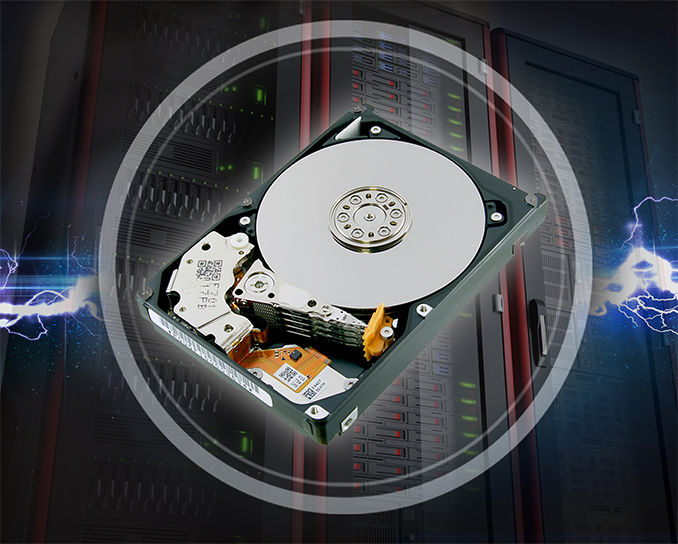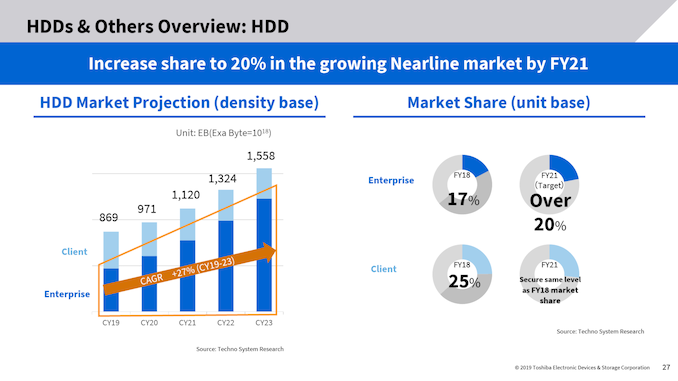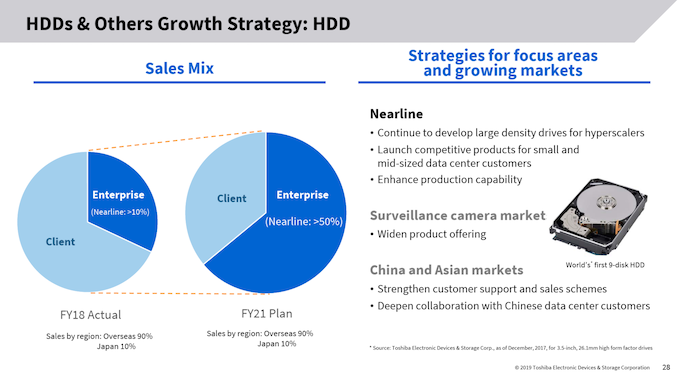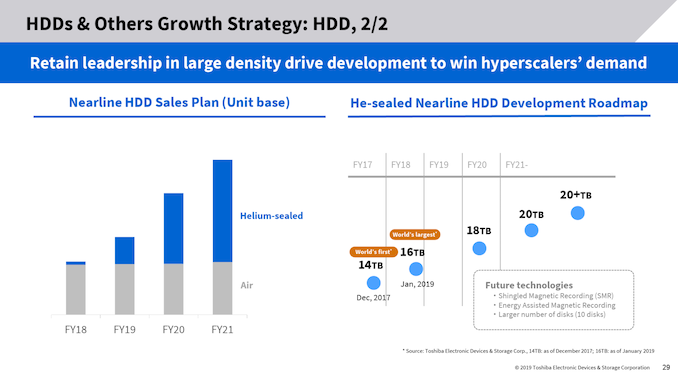Toshiba to Expand HDD Production: 20 TB & 10-Platter Drives Coming
by Anton Shilov on December 2, 2019 2:00 PM EST- Posted in
- Storage
- Toshiba
- HDDs
- Helium HDD

While hard drive sales on a unit basis have continued to decline, the drop hasn't been consistent across all segments of the market. In particular, high capacity drives for hyperscalers and other hosts continue to be a hot commodity, as their data storage needs continue to grow and there are few other alternatives. As such, Toshiba has announced that the company will actually be increasing its HDD production capacity, expanding one of its plants in Philippines to increase output of high-end helium-filled enterprise and nearline HDDs. The company is confident of its roadmap (and growing demand for its products) which includes numerous promising products and technologies.
The overall broad shift in HDD demand from lower capacity client to high capacity nearline drives comes as Toshiba finds itself on the outside looking in. The company’s sales mix is dominated by client HDDs, with enterprise drives accounting for about a third of it. So while Toshiba controls about 36% of the global mobile HDD shipments, it only has around 17% of the enterprise/nearline market. As a result, Toshiba is looking to make changes to capture more of the nearline market.
At its Investors Day last month, Toshiba outlined plans to radically increase the share of enterprise/nearline HDDs in its product mix in FY2021 (starts on April 1, 2021), shifting away from client drives and towards nearline drives. Overall, the company set itself a goal to capture an ‘over 20%’ share of the global enterprise/nearline HDD market while maintaining its share of the client HDD market at around 25%
To reach its new goals, Toshiba not only needs to ramp up production, but it will need to ensure it has competitive pricing and technology as well. This means the company needs to continue to invest in developing leading-edge high-capacity nearline drives for hyperscale datacenters, while at the same time keeping prices in check so that they are priced competitively for the small and mid-sized datacenter market. As well, Toshiba will have to focus on client issues, such as improving its customer support as well as collaborating more with Chinese datacenter clients.
On the product side of things, Toshiba has a rather solid roadmap. Earlier this year the company confirmed that it would use shingled magnetic recording (SMR) and energy assisted magnetic recording (EAMR) technologies (e.g., MAMR, HAMR) to boost areal density. In addition to that, the company’s roadmap now officially includes drives with 10 platters (up from nine today). Which to offer some context, a 10-platter design using the highest-capacity platters available today would enable a 22 TB HDD. Though it bears mentioning that adding a 10th platter to existing drives is not a trivial task (i.e. how do you fit it in?), so Toshiba isn't disclosing when they expect to have their 10-platter design ready.
In the meantime, the company’s roadmap includes a 20 TB HDD as soon as FY2021. And, going forward, all of Toshiba's leading-edge hard drives will be helium-filled.
The big challenge – as is often the case – is on the manufacturing side of matters. Toshiba’s current capacity to build helium-filled devices in its Carmelray Industrial Park plant is somewhat limited, so the company needs to expand these production lines to meet demands it is going to face in the coming years. It's fitting then that even Toshiba is being a bit cautious here, holding off on disclosing specific production goals for helium drives.
Related Reading:
- Toshiba's HDD Tech Roadmap: A Mix of SMR, MAMR, TDMR, and HAMR
- 18 TB HDDs: Toshiba Collaborates with Showa Denko for MAMR HDDs
- Toshiba at CES 2019: World’s First 16 TB TDMR HDD Debuts
- Toshiba Launches 12 TB and 14 TB HDDs for Desktops and NAS
- Demand for HDD Storage Booming: 240 EB Shipped in Q3 2019
- Shipments of PC Hard Drives Predicted to Drop By Nearly 50% in 2019
- Seagate to Shut Down One of Its Largest HDD Assembly Plants
- Western Digital to Shut Down HDD Manufacturing Facility, Increase Production of SSDs
Source: Toshiba














18 Comments
View All Comments
ikjadoon - Monday, December 2, 2019 - link
I'm hoping this means NAS/enterprise drives finally move the needle in cost/TB. We've been at $25/TB for half a decade (if not longer?). 2014 to 2019 came & passed us by with essentially zero price changes per TB.Surely 6 TB / 8 TB drives should've dropped in price by now, but nope.
azfacea - Monday, December 2, 2019 - link
i dont believe these enterprise growth projections for one nano second. this largely assumes the growth of content (online video) will go to hard drives. thats where they are dead wrong. hard drive bandwidth and performance is not good enough for these use cases requiring RAID and replication games of all sorts. SSDs can serve this traffic with much lower replication factor.cold storage and not content is what these drives will be useful for. their growth estimates are pure fantasy
TheinsanegamerN - Tuesday, December 3, 2019 - link
SSDs are WAYYY too expensive for large scale video storage, and online video projects already have issues turning a profit.GreenReaper - Tuesday, December 3, 2019 - link
Lots of content is cold. We have some 8-year-old content. Much of it *could* be accessed at any point, but probably won't be - if it is, it needs to be available within a second or so. HDD's good for this.Don't get me wrong, we'd love to go full-SSD, but today we can't really do that on a single server. It's close, but not quite the default yet, and not at our price point. Soon, yes. For now, NVMe+HDD.